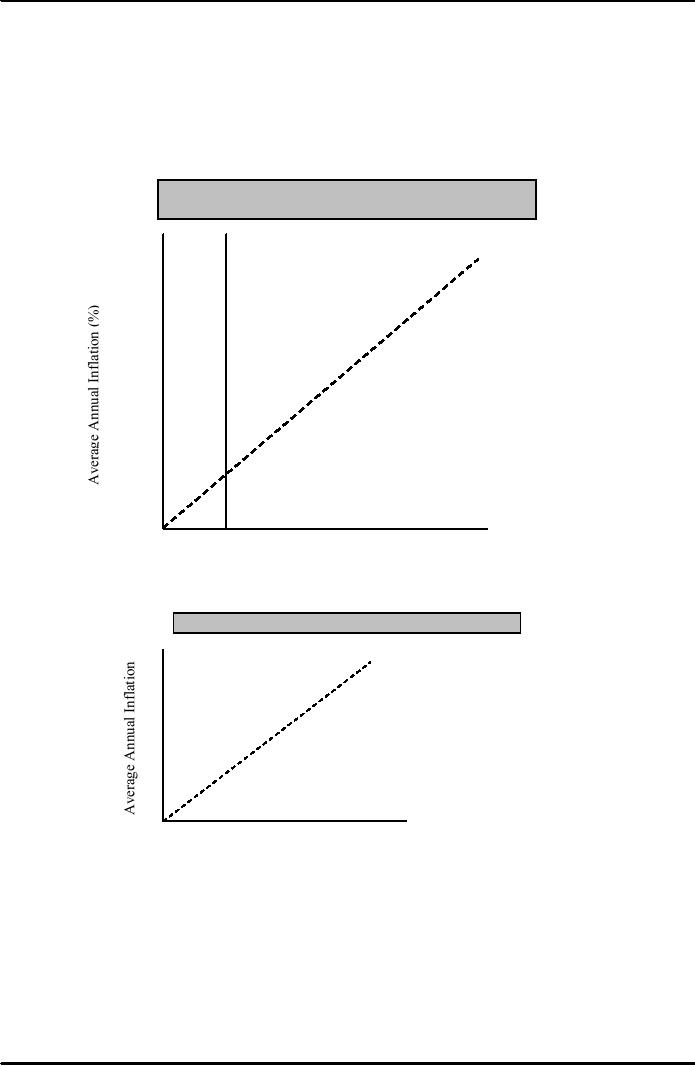 |

Money
& Banking MGT411
VU
Lesson
37
WHY
DO WE CARE ABOUT MONETARY
AGGREGATES?
Every
country with high inflation
has high money growth;
thus to avoid sustained
episodes of
high
inflation, a central bank
must be concerned with money
growth.
It
is impossible to have high, sustained
inflation without monetary
accommodation.
Monetary
Aggregates
Figure:
Inflation and Money
Growth:
Moderate-Inflation
Countries, 1981-2003
50
45� Line
�
40
�
�
�
30
�
�
�
�
20
�
�
�
�
�
�
�
�
�
�
��
10
�
�
�
�
0
10
20
30
40
50
Average
Annual Money Growth
(%)
Figure:
Money, Growth and
Inflation
45� Line
Inflation>Money
Growth
Money
Growth <Inflation
Average
Annual Money Growth
When
the currency that people are
holding loses value much
rapidly, they will work to
spend
what
they have as quickly as possible
This
will have the same effect on
inflation as an increase in money
growth
It
is impossible to have high, sustained
inflation without monetary
accommodation.
Something
beyond just differences in
money growth accounts for
the differences in inflation
across
countries.
116

Money
& Banking MGT411
VU
Velocity
and the Equation of
Exchange
To
understand the relationship between inflation and
money growth we need to focus on
money
as
a means of payment.
Consider
an example of four
students
Ali
has Rs. 100 in
cash
Bilal
has a Rs. 100
calculator
Chohan
has 2 tickets worth Rs. 50
each for a cricket
match
Dilawer
has a set of 25 drawing
pencils worth Rs. 4
each
Ali
needs a calculator which he buys
from Bilal.
Bilal
wishes to see the match so he buys the
tickets from Chohan
Chohan
uses the proceeds to purchase the
drawing pencils from
Dilawer
Total
Value of the transactions is
(Rs.
100 x 1 calculator) + (Rs. 50 x 2
tickets) + (Rs. 4 x 25 pencils) =
Rs. 300
Generally
No.
of Rupees x No. of time each
Re is used = Rs. Value of
Transactions
The
number of times each rupee is used (per
unit of time) in making
payments is called
the
velocity
of money; the more frequently each
rupee is used, the higher the
velocity of money
Applying
to economy wide transactions:
Quantity
of Money x Velocity of Money =
Nominal GDP
Using
data on the quantity of money
and nominal GDP we can
compute the velocity of money;
each
monetary aggregate has its
own velocity
If
we represent
Money
with M
Velocity
with V
Price
level with P
Real
GDP with Y
Nominal
GDP = P x Y
Substituting,
we get
MxV=PxY
The
equation of exchange, MV=PY provides the
link between money and prices if we
rewrite it
in
terms of percentage
changes
The
Quantity Theory and the
Velocity of Money
MV
=
PY
or
%
ΔM
+
% ΔV =
% ΔP +
% ΔY
Money
Growth + Velocity Growth =
Inflation + Output
Growth
In
the early 20th century,
Irving Fisher wrote down the
equation of exchange and derived
the
implication
that
Money
growth + velocity growth =
inflation + real
growth
Assuming
No
important changes occur in payment
methods or the cost of holding
money,
Real
output is determined solely by economic
resources and production
technology,
Then
changes in the aggregate price
level are caused solely by
changes in the quantity of
money.
In
other words
Assume
that %ΔV = 0 and
%ΔY =
0.
Doubling
the quantity of money doubles the price
level.
Inflation
is a monetary phenomenon (Milton
Friedman).
117

Money
& Banking MGT411
VU
In
our example of four
students, number of rupees needed equaled
total rupee value of
the
transaction
divided by no. of times each rupee
was used
Money
demand = Total value of
transaction
Velocity
of Money
For
the economy as a whole,
Money
demand = Nominal GDP
Velocity
Md =
1/V x PY
Money
Supply (Ms)
is determined by central bank
and the behavior of the banking
system
Equilibrium
means Md =
Ms = M
Rearranging
the Money demand function
gives MV = PY
The
quantity theory of money
tells us why high inflation
and high money growth go
together,
and
explains why countries can have
money growth that is higher
than inflation (because
they
are
experiencing real
growth).
The
Facts about Velocity
Fisher's
logic led Milton Friedman to
conclude that central banks
should simply set
money
growth
at a constant rate.
Policymakers
should strive to ensure that
the monetary aggregates grow at a rate
equal to the
rate
of real growth plus the desired
level of inflation.
118
Table of Contents:
- TEXT AND REFERENCE MATERIAL & FIVE PARTS OF THE FINANCIAL SYSTEM
- FIVE CORE PRINCIPLES OF MONEY AND BANKING:Time has Value
- MONEY & THE PAYMENT SYSTEM:Distinctions among Money, Wealth, and Income
- OTHER FORMS OF PAYMENTS:Electronic Funds Transfer, E-money
- FINANCIAL INTERMEDIARIES:Indirect Finance, Financial and Economic Development
- FINANCIAL INSTRUMENTS & FINANCIAL MARKETS:Primarily Stores of Value
- FINANCIAL INSTITUTIONS:The structure of the financial industry
- TIME VALUE OF MONEY:Future Value, Present Value
- APPLICATION OF PRESENT VALUE CONCEPTS:Compound Annual Rates
- BOND PRICING & RISK:Valuing the Principal Payment, Risk
- MEASURING RISK:Variance, Standard Deviation, Value at Risk, Risk Aversion
- EVALUATING RISK:Deciding if a risk is worth taking, Sources of Risk
- BONDS & BONDS PRICING:Zero-Coupon Bonds, Fixed Payment Loans
- YIELD TO MATURIRY:Current Yield, Holding Period Returns
- SHIFTS IN EQUILIBRIUM IN THE BOND MARKET & RISK
- BONDS & SOURCES OF BOND RISK:Inflation Risk, Bond Ratings
- TAX EFFECT & TERM STRUCTURE OF INTEREST RATE:Expectations Hypothesis
- THE LIQUIDITY PREMIUM THEORY:Essential Characteristics of Common Stock
- VALUING STOCKS:Fundamental Value and the Dividend-Discount Model
- RISK AND VALUE OF STOCKS:The Theory of Efficient Markets
- ROLE OF FINANCIAL INTERMEDIARIES:Pooling Savings
- ROLE OF FINANCIAL INTERMEDIARIES (CONTINUED):Providing Liquidity
- BANKING:The Balance Sheet of Commercial Banks, Assets: Uses of Funds
- BALANCE SHEET OF COMMERCIAL BANKS:Bank Capital and Profitability
- BANK RISK:Liquidity Risk, Credit Risk, Interest-Rate Risk
- INTEREST RATE RISK:Trading Risk, Other Risks, The Globalization of Banking
- NON- DEPOSITORY INSTITUTIONS:Insurance Companies, Securities Firms
- SECURITIES FIRMS (Continued):Finance Companies, Banking Crisis
- THE GOVERNMENT SAFETY NET:Supervision and Examination
- THE GOVERNMENT'S BANK:The Bankers' Bank, Low, Stable Inflation
- LOW, STABLE INFLATION:High, Stable Real Growth
- MEETING THE CHALLENGE: CREATING A SUCCESSFUL CENTRAL BANK
- THE MONETARY BASE:Changing the Size and Composition of the Balance Sheet
- DEPOSIT CREATION IN A SINGLE BANK:Types of Reserves
- MONEY MULTIPLIER:The Quantity of Money (M) Depends on
- TARGET FEDERAL FUNDS RATE AND OPEN MARKET OPERATION
- WHY DO WE CARE ABOUT MONETARY AGGREGATES?The Facts about Velocity
- THE FACTS ABOUT VELOCITY:Money Growth + Velocity Growth = Inflation + Real Growth
- THE PORTFOLIO DEMAND FOR MONEY:Output and Inflation in the Long Run
- MONEY GROWTH, INFLATION, AND AGGREGATE DEMAND
- DERIVING THE MONETARY POLICY REACTION CURVE
- THE AGGREGATE DEMAND CURVE:Shifting the Aggregate Demand Curve
- THE AGGREGATE SUPPLY CURVE:Inflation Shocks
- EQUILIBRIUM AND THE DETERMINATION OF OUTPUT AND INFLATION
- SHIFTS IN POTENTIAL OUTPUT AND REAL BUSINESS CYCLE THEORY